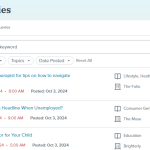Getting featured on major media outlets like Forbes, Business Insider, or The New York Times sounds like a dream, right? But it’s not just luck that gets you there. It’s about nailing the perfect HARO (Help A Reporter Out) pitch. When facing stiff competition, sending a pitch that stands out in a sea of responses is your best shot at securing that coveted feature.
In this piece, you’ll find out precisely how to craft a HARO pitch that gets noticed and helps you land features in top-tier publications. Let’s dive in.
What is HARO, and Why is It Essential for You?
HARO (Help A Reporter Out) is a bridge between reporters and experts. It’s a simple, powerful platform where journalists post queries looking for expert quotes, insights, or stories. You respond, and if your pitch hits the mark, you could be featured in their articles.
HARO proves to be an indispensable tool for brands, entrepreneurs, and side hustlers alike. Securing a feature on a major outlet can significantly boost your credibility, generate substantial traffic to your website, and, most importantly, obtain those essential SEO backlinks that improve your rankings on Google. Nevertheless, the competition is fierce, with journalists sifting through a vast number of pitches every day. To truly stand out, you need more than just a good concept—you need an outstanding and compelling pitch.
Anatomy of the Perfect HARO Pitch
You can’t just throw a pitch together and expect magic. Every piece of your HARO pitch needs to serve a purpose. Let’s break it down.
1.Subject Line: Stand Out or Get Ignored
Your subject line is your first impression, and it better count. If a journalist gets a flood of emails, only the most compelling subject lines will get opened. Keep it short and to the point, but make it specific. For example:
- “Expert Insights on Remote Work Trends for 2024”
See how this immediately tells the reporter you’re offering expertise on a relevant, timely topic. Journalists are busy. Please don’t make them guess what your email is about.
2.Introduction: Build Credibility Fast
Your first few lines need to show why you’re qualified. You don’t have to boast but do highlight your expertise. Introduce yourself like this:
- “Hi [Reporter’s Name], I’m Sarah James, a digital marketing strategist with over 12 years of experience helping e-commerce brands scale through SEO and content strategies.”
Boom! In one sentence, you’ve established who you are and why the journalist should trust you. Remember, the reporter’s job is to find experts. Make their job easy.
3.Answer the Query Directly
Now, let’s talk meat and potatoes. Journalists want straightforward answers, not fluff. Address their query directly, and don’t bury the lead. For example, if a journalist is asking about trends in e-commerce, start with a brief, clear response that gets right to the point:
- “In 2024, we’re seeing a sharp shift towards AI-driven customer service in e-commerce. This trend enhances user experience and drives efficiency in handling high volumes of customer inquiries.”
Specific insights like this grab attention because they show you understand the topic deeply.
4.Provide Value with Data or Examples
Don’t just state facts; back them up with evidence. Offer data, research, or real-world examples to give your pitch weight. Journalists love well-researched answers because it makes their writing stronger. For example:
- “In a recent survey we conducted, 72% of online shoppers reported that personalized AI assistance made them more likely to complete a purchase. This aligns with industry predictions that AI will handle 80% of customer interactions by 2025.”
This level of detail shows the journalist that you’re not just talking; you know what you’re talking about.
5.Call to Action: Make Yourself Available
End your pitch by offering more. Leave the door open for further conversation:
- “If you need any additional insights or examples, I’d be happy to help. Let me know if you’d like to jump on a quick call.”
This small step shows that you’re serious about helping the journalist succeed.
How to Get Your HARO Pitch Noticed by Journalists
Okay, you’ve got the structure down. Now, let’s talk strategy.
- Research the Journalist and Their Outlet
You wouldn’t walk into a meeting without knowing who you’re talking to, would you? Before you even think about writing your pitch:
- Do your homework.
- Look up the journalist’s past work and understand their style.
- Tailor your pitch to their beat. If a journalist writes about sustainability, don’t pitch them your latest tech startup—unless it’s green tech.
- Be Concise But Comprehensive
Journalists are drowning in emails. Keep your pitch short but packed with valuable information. Aim for at most three paragraphs in your response. Answer the query, support it with data, and close with a call to action. If you ramble or stuff too much in there, your email will end up in the trash.
Offer Something Unique
What makes your expertise stand out? Think about the journalist’s audience—what’s in it for them? Offer a unique angle or give them insights that they can’t find from anyone else. For instance, if you have proprietary data, mention it. If you’ve got a different take on a hot topic, highlight that.
Common Mistakes to Avoid
HARO is competitive, so avoid these rookie mistakes:
Generic or Vague Responses
Nothing kills a pitch faster than a generic response. Journalists can smell copy-paste jobs from a mile away. Every pitch needs to be unique to the query you’re answering. Keep the subject line and blast the same email.
Overloading with Information
You’re not writing a novel here. If a journalist asks for a quick quote on a specific topic, don’t give them your life story. Stick to the point. Less is often more.
Ignoring Instructions
If the query asks for 150 words, send less than 500. Journalists set guidelines for a reason. Follow them. Not doing so is a sure way to get ignored.
Examples of Successful HARO Pitches
Want proof this works? Here’s a quick example of a pitch leading to a Forbes feature.
Subject Line: “Data-Driven Insights on Remote Work Trends for 2024”
Pitch: “Hi [Reporter’s Name],
I’m John Doe, a workplace strategist with 15 years of experience helping Fortune 500 companies navigate remote work transitions. In our latest survey, 85% of remote workers reported an increase in productivity due to flexible schedules.
One trend we’ve noticed is the growing demand for hybrid work models, especially in industries like tech and finance. These sectors are investing heavily in tech infrastructure to support this transition, with predictions indicating that by 2025, 60% of companies will adopt a hybrid approach.
I’d be happy to provide more detailed data or case studies; let me know if you’re interested!
Best,
John”
Short, sweet, and loaded with value.
Maximizing Your Chances of Getting Featured
You’ve written a killer pitch. Now, here’s how to boost your chances even more:
Be Consistent
You won’t get featured every time, but persistence pays off. The more pitches you send, the more you learn what works. Keep showing up and fine-tuning your approach.
Follow Up (Politely)
If you have been waiting to hear back in a week or so, sending a gentle follow-up is okay. Just don’t be pushy. Like, “Hey [Name], I’m checking in to see if you need any more info on this topic. “
Build Relationships
Think of journalists as something other than one-time contacts. Build relationships with them over time by consistently offering helpful insights. This will increase your chances of being featured again and again.
Final thought
Writing the perfect HARO pitch isn’t rocket science but requires a thoughtful approach. You’re stacking the odds in your favour when you follow the steps here. Remember to be specific, offer real value, and always make it easy for the journalist to say, “Yes, I’ll use this!”
Go out there and get featured on major media outlets!
Step into the spotlight and get featured on major media outlets!
 logo
logo


